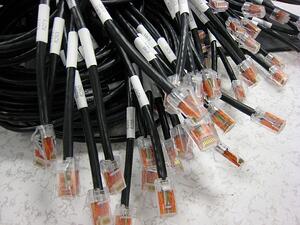
Users have always sought more speed. Faster data rates mean more high-bandwidth applications like voice-over-IP and streaming video. Today, networking speeds of 1 Gbps to 10 Gbps are fairly common, but network speeds are becoming too fast. For the first time there are working groups trying to devise slower Ethernet standards to fill the gap between 1 Gigabit Ethernet and 10 Gigabit Ethernet speeds to preserve the current copper cable infrastructure.
Since the Ethernet standard was first finalized by the IEEE in 1984, engineers have been developing new ways to expand network bandwidth over copper twisted-pair cable. The challenge has been the limitations of data capacity for Category 5 and Category 6 copper cabling, which are the predominant network cable installed today – they can’t handle high-speed networking over long distances.
In brief, network speeds are exceeding the capacity of most of the network cable already installed around the world. Cat 5 and Cat 6 cabling don’t support 10G Ethernet up to 100 meters, which is why an intermediate data rate is needed that falls between 1 Gbps and 10 Gbps. It’s time to create "in between" network technology to preserve the value of the existing copper cable plant.
Wireless Is Overtaking Cable
The real driving factor for adopting new 2.5G and 5G is the need to keep pace with the increasing data rates of wireless networking.
The new 802.11ac Wi-Fi standard increases wireless bandwidth, supporting Ethernet speeds of 1.7 Gbps to 2.5 Gbps. With the coming of the next generation of wireless networking, 802.11ac Wi-Fi Wave 2, wireless network speeds could increase to as high as 6.8 Gbps.
For the first time, the wireless access points (WAPs) that are connected to the wired network are delivering data at rates faster than the Cat 5 and Cat 6 cable can handle. According to Cisco, 52 percent of all mobile data traffic is going to be transferred from cellular to fixed networks using Wi-Fi by 2018. As more wireless data is aggregated at the WAPs it’s going to require both the access point and the Ethernet switch it’s connected to scale beyond 1G.
Rather than ripping out the installed Cat 5 and Cat 6 cable in favor of fiber, the industry has wisely decided to create new 2.5G Ethernet and 5G Ethernet standards to match the new higher speed wireless data rates. Of course, the industry still has to agree on the new standards.
 Dueling 2.5G Ethernet Standards
Dueling 2.5G Ethernet Standards
There are currently two groups working on a new 2.5G Ethernet and 5G standards to present to the IEEE.
The NBASE-T Alliance was formed in October to address the problem with the participation of leading networking vendors such as Aquantia, Brocade, Cisco, Freescale Intel, and Xilin. The NBASE-T Alliance is seeking to develop “a new type of signaling over twisted-pair cabling. Should the silicon have the capability, auto-negotiation can allow the NBASE-T solution to accurately select the best speed: 100 Megabit Ethernet (100MbE), 1 Gigabit Ethernet (GbE), 2.5 Gigabit (2.5GbE) and 5 Gigabit (5GbE).”
In December another consortium, the MGBASE-T Alliance, was formed with the support of companies such as Aruba Networks, Avaya, Broadcom, Brocade, Delta Electronics, Pulse Electronics, and Ruijie Networks. The MGBASE-T Alliance has the same goals as the NBASE-T Alliance; to create a new Ethernet standard to bridge the gap between 1G and 10G Ethernet equipment.
With leading networking hardware and silicon manufacturers hard at work on two different approaches to solve the same problem, new 2.5G Ethernet and 5G standards are likely to emerge soon. And as one member of the MGBASE-T Alliance noted, the new standard is likely to leverage a lot of existing technology so no matter what the outcome, you can be sure that your current Cat 5 and Cat 6 network infrastructure will continue to perform for some time to come.
Images Courtesy of: StockPhotos via http://stockphotos.io/











